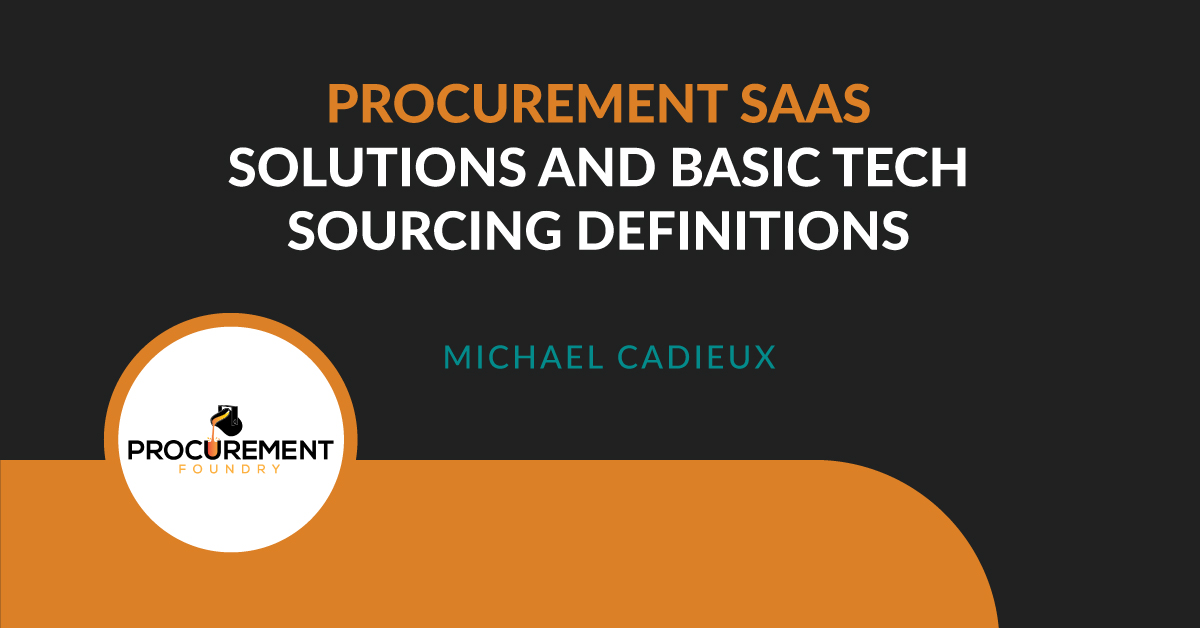Maximizing Savings Opportunities and Procurement's Strategic Value for CPOs
Saving money is not always about pinching pennies: advanced and data-driven insights enable you to identify real cost-saving opportunities, negotiate...
3 min read
![]() Michael Cadieux
:
7/8/22 2:58 PM
Michael Cadieux
:
7/8/22 2:58 PM

Every procurement team relies on SaaS, but before implementing and finding the best procurement SaaS solutions, they must first understand the different parts of SaaS. Our rundown of procurement SaaS solutions and basic tech sourcing definitions will help you improve your SaaS process.
SaaS is an acronym that stands for software as a service (SaaS), which according to Gartner, is “software that is owned, delivered and managed remotely by one or more providers.” Gartner adds, “The provider delivers software based on one set of common code and data definitions that is consumed in a one-to-many model by all contracted customers at anytime on a pay-for-use basis or as a subscription based on use metrics.”
Now, that is the official definition, but you may be wondering: What does that have to do with procurement? Or, more importantly, why should I care? Let’s look into how it all fits together.
Many procurement professionals may not realize how much of a secret weapon SaaS can be. Not only can it help with negotiations, contracts, purchasing compliance, cleansing data, and much more, but since SaaS is hosted in the cloud it is constantly improving. No need to wait for a new disc each year.
Regarding IT sourcing, these models can offer great solutions by providing access to data and more, but only when they are used correctly. Otherwise, as a service models can be a waste of money. Let’s dive into some essential tech sourcing definitions.
Gathered below are some of the foundational definitions you should be familiar with to help you navigate—and optimize—SaaS.
We already defined SaaS above, but I thought it would be good to provide a tangible example of a SaaS application. Adobe Creative Cloud or Microsoft suite are examples that have been around for some time and are popular in nearly all corporate environments. In procurement, you may be more familiar with SAP or Oracle, but it’s likely you oversee SaaS subscription, terms, and conditions for your org.
But, is SaaS different than the cloud?
Since SaaS is referred to as a cloud-based model, you need to know what that means. Basically, all the maintenance work of software—including updates, delivery, and more—is done by the operating organization via data stored in what is known as the cloud. It is an internet-based environment removing the need for hard copy storage and discs.
Why should you care? The reason is simple: even if you don’t understand all the nuances of the “cloud,” the bottom line is that this is the resting place for ALL your data to be stored and accessed instantly and easily from wherever you are. This eliminates the old-school need to store data on your computer’s hard drive.
The SaaS business model is pretty straightforward. These companies sell a cloud-based software to users for a monthly or annual subscription fee. The operating model and cost of the operating model is where procurement comes in.
VAR, an acronym that stands for Value-Added Reseller, is a company that enhances your products through unique add-ons like customized products or services, upping the value for resale to end-users. The most common services VARs provide include extra hardware, installation services, consulting, and troubleshooting.
So, why do value-added resellers matter in the information technology (IT) industry? Investopedia explains it well and shares an example of this process at work with Cisco and its reseller program.
According to Investopedia, “Value-added resellers exist because they represent an important distribution channel for manufacturers, particularly those in the IT sector. A value-added reseller takes a core hardware or software product or an entire system and customizes a package of additional system add-ons for a customer.” So, even though the reseller is not the creator of the product, its unique insights allow it to add extreme value due to its thorough knowledge (thanks to IT data) on how to best customize, install, test, and maintain it for the customer.
An Asset Management Database (AMDB) is where all the data you need to support Availability Management is. This is the data that helps with tasks like report generation, statistical analysis, and availability forecasting.
Companies use this to help them keep track of assets ranging the spectrum, including things like company vehicles, equipment, investments, and more—all of which help streamline operations and ensure optimum efficiency and economy.
This barely touches tech sourcing and procurement’s responsibilities. An in-depth knowledge of all of these factors and how they work is absolutely required in procurement today. Our days of analog spreadsheets are coming to a close and procurement must adapt with the times!
Interested in learning more, including discovering more about SaaS best practices? Join the Foundry today.

Saving money is not always about pinching pennies: advanced and data-driven insights enable you to identify real cost-saving opportunities, negotiate...

The topic of our recent roundtable discussion with a dozen Procurement Foundry community members—exploring potential flaws in procurement incentive...

Every 30 days or so, I get the same alert on my phone—“Your electricity bill is available for viewing.” I take a quick look, make sure nothing seems...